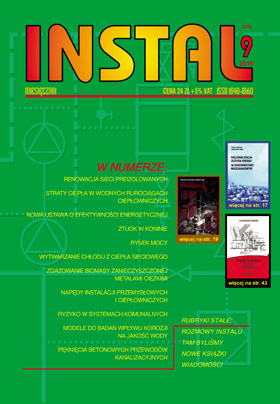Zapisywanie danych...
Abstract: The purpose of this paper was to analyse the relationship between crack width and deformation of various diameters of concrete sewer pipes. The differences between classification of longitudinal cracks and deformation were demonstrated. It was noted that the horizontal diameter of deformed pipe changes more than the vertical diameter. In addition, it was proved that the crack of the same width leads to various magnitude of deformation depending on the diameter of pipe, therefore it affects differently on sewer collapse risk. This fact should be taken into account in longitudinal cracks classification by assuming different crack width tresholds for various pipe diameters. It was pointed out that the relationship between these defects should be taken into account in assessment the impact of longitudinal cracks and deformation on sewer pipe condition.
B I B L I O G R A F I A[1] Centre for Expertise and Research on Infrastructures in Urban Areas
(CERIU): Manuel de Standardization des Observations, 2nd Ed., CERIU, Montreal, Quebec, Canada, 2004
[2] Davies J., Clarke B., Whiter J., Cunningham R.: Factors influencing the structural deterioration and collapse of rigid sewer pipes. Urban Water 3(1–2), 2001, p. 73-89
[3] DWA-M 149-3 Zustandserfassung und -beurteilung von Entwässerungssystemen außerhalb von Gebäuden, Teil 3: Zustandsklassifizierung und -bewertung, November 2007
[4] http://www.unitracc.com/know-how/fachbuecher/rehabilitation-and-maintenance-of- drains-and-sewers/damage-its-causes-and-its consequences/cracks-pipe-breaks- collapse-en/longitudinal-cracks/description-of-damage-en
[5] John van Rijn: Maintaining Sewer Systems, INDEVELOPMENT, 2006 (http://www.indevelopment.nl/PDFfiles/maintainingSewerSystems.pdf)
[6] Kuliczkowska E.: Analiza rys i pęknięć w przewodach kanalizacyjnych badanych metodą CCTV, Inżynieria i Budownictwo, R. 72, nr 1, 2016, s. 16 - 19
[7] Kuliczkowska E.: Możliwe rozbieżności w ocenach stanu technicznego przewodów kanalizacyjnych, Instal, nr 10, 2014, s.79-82
[8] Kuliczkowski A..: Uwagi krytyczne dotyczące stosowanych klasyfikacji uszkodzeń przewodów kanalizacyjnych, Instal. Teoria i praktyka w instalacjach Nr 4, 2007, s. 42-47
[9] Law T.C.M.: Behaviour of tight fitting flexible pipe liner under earth loads, 35 thesis for the degree of Doctor of Philosophy, University of Western Ontario, London, Ontario, Canada, 2004
[10] Law T.C.M., Moore I.D.: Kinematic response of damaged rigid sewer under earthload, Proc. of Annual Conference, Canadian Geotechnical Society, Niagara Falls, ON, October 2002
[11] Law T.C.M. and Moore I.D.: Numerical modeling of tight fitting flexible liner in damaged sewer under earth loads, Tunnelling and Underground Space Technology, 22, 2007, s. 655–665
[12] Law T.C.M, Moore I.D.: Response of repaired sewers under earth loads, Transportation Research Record, No. 1845, 2003, p. 173-181
[13] New Zealand Pipe Inspection Manual, 2006
[14] Olliff J. L.: Factors of safety in the structural design of large sewers. Proceedings of the 1st international symposium on urban drainage systems, Southampton, September 1992
[15] Serpente P. E.: Understanding the modes of failure for sewers. W. A. Macaitis (Ed.), Urban drainage rehabilitation programs and techniques selected papers on urban drainage rehabilitation from 1988–1993. New York: ASCE, 1994
[16] Tan Z.: Nonlinear finite element study of deteriorated rigid sewers including the influence of erosion voids, Thesis (Master, Civil Engineering) Queen's University, 2007
[17] Tan Z., Moore I.D.: Effect of backfill erosion on moments in buried rigid pipes, Transportation Research Board Annual Conference, Washington D.C. January 2007
[18] Trott J. J., Nath P., O'Reilly M. P.: Longitudinally cracked pipes and their structural capacity., Restoration of sewerage systems. London, 1982
[19] WRc Sewerage Rehabilitation Manual, Fourth Edition. Volume I - Rehabilitation planning, Water Research Centre, U.K., 2001
[20] WRc Sewerage Rehabilitation Manual, Second Edition, Water Research Centre, U.K., 1994
[21] Zhao J.Q., McDonald S.E., Kleiner Y.: Guidelines for Condition Assessment and Rehabilitation of Large Sewers, Institute for Research in Construction, National Research Council of Canada, 2001 (NRCC 45130) 
